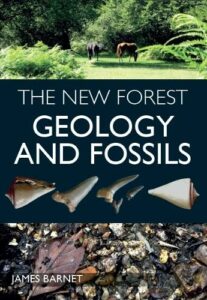By James Barnet

Those of you who have read a few of my book reviews will know that I love geo-guides to small geographical areas, rather than just the big geological scientific issues. In fact, there are lots of good UK guides like this one, to areas such as Dorset and Yorkshire, and many areas of Scotland and Wales, for example. And this is another excellent example of that genre.
OK, the author does use a couple of boreholes in the New Forest in Hampshire in the south of England as an excuse to bring in discussions of the Jurassic Coast World Heritage Site and a chapter on looking for oil in the south of England – he has worked extensively in the petroleum industry – but who can blame him? They are really fascinating topics.
In fact, the book is the first I have seen on the New Forest of Hampshire. It is clearly intended to be the most complete and up-to-date guide to the geology and fossils of this area, and is aimed at both the informed amateur fossil collector and the professional geologist, with about 200 field photographs, palaeogeographic maps, digitised borehole/outcrop logs, and geological cross sections. And, given that the area has been a National Park since 2005, the combination of great geology and scenery makes a great combination.
The guide includes details of the regional geological evolution of southern England since the Permian Period (about 280 Ma), based on deep boreholes and coastal exposures, including the coast of Dorset and east Devon. In addition, it discusses the petroleum geology of southern England and the New Forest, and gives a detailed overview of the stratigraphy of the Hampshire Basin, together with the economic geology of the area, including ironstones, freshwater aquifers, geothermal energy, sand, clay and peat resources. Finally, there is an up-to-date and complete account of the principal fossil localities in New Forest (principally rivers), together with full-colour photographs and descriptions of the most common fossils that can be found within the New Forest National Park.
However, it is his discussion of the Palaeogene of the south of England that I found the most interesting. The fossil locations in the New Forest itself are all Eocene in age, which obviously necessitates a detailed discussion of that epoch, but there are few books that cover the geology of this geological period in the UK. Therefore, this is a welcome addition for anyone wishing to examine non-Mesozoic exposures, other than the more obvious ones like Bracklesham Bay and Barton-on-Sea (also covered by the guide). And for that reason alone, I would recommend the book – a local guide to the Palaeogene of the UK.
The author, Dr James Barnet, grew up in the New Forest. He became interested in geology from an early age after finding the 50-million-year-old shells of marine organisms and sharks’ teeth in a riverbed near his home. He graduated from the University of Southampton in 2008 with a First Class Master’s Degree in Geology, before working for an oil and gas consultancy company in Oxfordshire. He graduated with a PhD in 2018 at the University of Exeter in past greenhouse climates on earth, which may represent analogues for anthropogenic climate change.
The New Forest: Geology and Fossils, by James Barnet, The Crowood Press Ltd, Marlborough, Wiltshire (2021), 160 pages (Paperback), ISBN-13 : 978-1785008160


